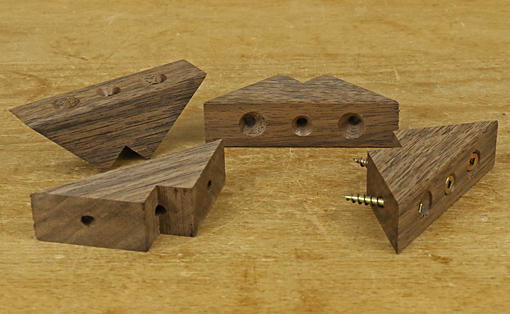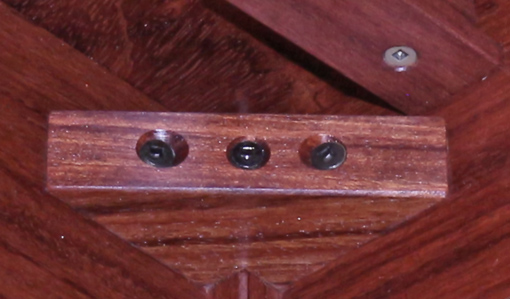
Corner blocks (corner braces) are a practical, effective way to strengthen furniture, particularly post and rail assemblies.
As previously discussed here, a properly designed and executed mortise and tenon joint will itself rarely fail but the wood around the mortise still can break. Two feet of leg extending below a table apron can impose huge leverage on the wood in the area of the joint.
Corner blocks are routinely used by chair makers but it surprises me when they are absent in tables where they could have been included. I use them whenever possible – belt and suspenders. Of course, sometimes there is no room for them, such as when a drawer is in the way, and sometimes they would disturb the appearance of the piece. The different mechanical stresses involved in casework make corner blocks generally less useful but there too they are still probably underutilized.
Working with tables
If the table aprons are at 90°, it is easy to make corner blocks with the table saw and miter gauge. The long side of the triangle could be as little as 3″ for a small table and 4 – 5″ or more for larger work. For thickness, 1 – 1 1/4″, using a single row of screws, is usually enough for small to medium work, though for large pieces, 2″ or more with a double row of screws is more in line.
I make corner blocks with a notch to accommodate the inner surfaces of the leg. I think it is best to leave a tiny gap between the block and the leg to avoid possible problems with wood movement that might affect the tenon shoulder line. However, in the past I have not always made a gap there and that has not caused problems.
If the aprons are not at 90° or are curved, I find it easiest to place a blank of wood diagonally spanning the aprons and simply trace the inside edges of the aprons and leg onto it, provided the top of the legs and aprons are flush. Then I bandsaw to the lines and, if necessary, refine the result with a plane. Alternatively, one straight cut, if required, could first be made on the table saw and used as a starting alignment. If the legs extend beyond top of apron, measure out and cut a notch, then place the blank and trace.
Another approach that is sound, though not my preference, is to make the block span the aprons but completely clear the leg. This sacrifices some glue area but should still be sturdy enough and seems easier to make.
Prepare the block by drilling and countersinking clearance holes for the screws. The center hole for the screw that will penetrate the leg is at 90° to the long edge of the block. I make the holes for the screws that will penetrate the aprons at 75°, not 45°, to the long edge of the block so there will be a good bulk of wood around the clearance hole. This also allows a little more screw length to penetrate the apron.
The blocks in the photo above show the features discussed.
I glue the blocks in place with Nexabond 2500M CA glue after sizing the end grain for about one minute, or similarly with quick set epoxy if the sawn surface is at all rough. After the glue sets, I drill pilot holes into the legs and drive those screws. Then I reset the masking tape depth stop and do the same for the apron screws, being extremely careful not to drill too far into the aprons.

If there is room for only a thin corner brace that cannot support a screw, a dovetailed attachment to the top of the aprons could be used. Otherwise, dovetailed attachments are difficult to make and unnecessary.


Hello,
Interesting post and a good aspect.
As I’m actually planning to build a table, your proposal could solve one of my problems.
I’ll check it.
Regards,
Stefan
Just found your website.
Have an old table that needs to have corner braces replaced but this solution looks a lot better.
Thanks,
Walter,
Yes, they’re easy and effective.
Rob